Lab 01 – Data Modeling
Scenario
A regional building department issues and tracks permits for new buildings and updates for remodeling of existing buildings. Throughout this course you will build applications and perform automation to enable the regional building department to manage the permitting process. This will be an end-to-end solution which will help you understand the overall process flow.
In this lab, you will set up a second environment to mimic a production environment for learning purposes and create solutions to track your changes. You will also create a data model to support the following requirements:
-
R1 – Track the status of permits issued for new buildings and existing building modifications
-
R2 – Permits are associated with a Build Site, which represents the building or land being modified
-
R3 – Permit type indicates the type of permit and inspections, other data that might be required on a permit
-
R4 – Inspections completed on the permit work are to be tracked for the entire process i.e., from request of inspection to the pass or fail of the inspection
-
R5 – Permits, for our lab purposes, are requested by a person and we need to track who requested each permit
High-level lab steps
To prepare your learning environments you will create a solution, a publisher, and add both new and existing components that are necessary to meet the application requirements. Refer to the data model document for the metadata description (tables, column types and relationships). Your solution will contain several tables upon completion of all the customizations.
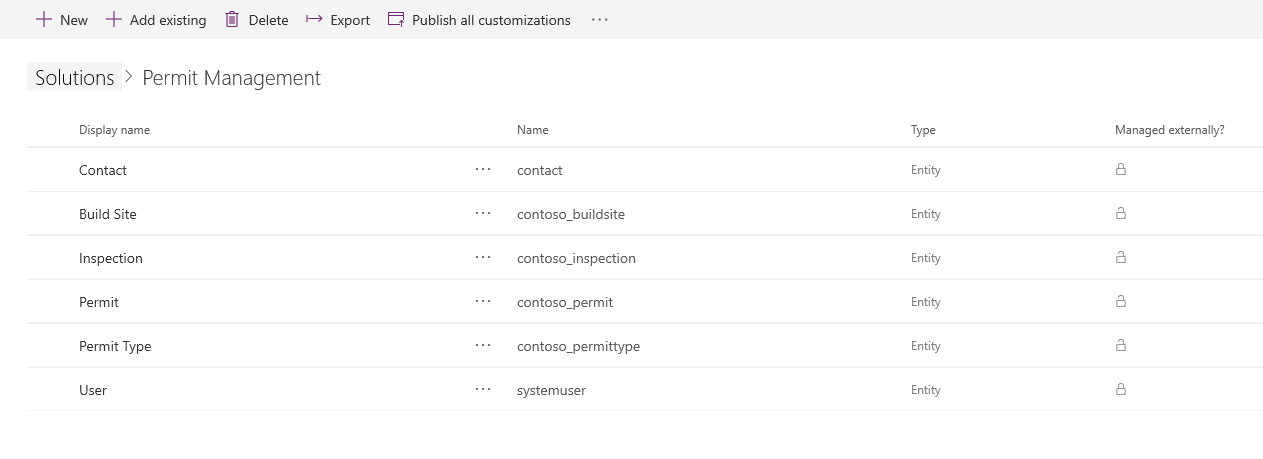
Things to consider before you begin
-
What are considered as best practices for managing changes in between environments (“Dev” to “Test” to “Prod”)? Are there additional considerations for team solution development?
-
What tables a user might need in the scenario that we are building?
-
What relationship behaviors would we consider enabling users to complete their tasks?
-
Remember to work in your DEVELOPMENT environment with the customizations. Once the customizations are completed, published and tested in “Dev”, and if everything works fine, the same will be deployed to “Prod”.
Exercise #1: Create Environments and Solution
Objective: In this exercise, you will create a community plan environment to mimic Production environment that we will refer to as “Prod”.
Task #1: Create Environments
-
Create the community plan environment
- Navigate to Power Apps Community Plan page
- Click on Existing user? Add a dev environment
- Enter your credentials when prompted to sign in
- Select your country from the dropdown menu and click Accept
- Navigate to Power Platform Admin Center to see a new environment has been created by the system. We will refer to it as “Prod” environment for the rest of this course.
You should now have the dev environment and the “Prod” environment listed under environments.
Task #2: Create Solution and Publisher
-
Create Solution
-
Sign in to Power Apps maker portal
-
Select your Dev environment.

-
Select Solutions from the left menu and select + New solution.
-
Enter Permit Management for Display Name.
-
-
Create Publisher
- Select the + New Publisher button below Publisher dropdown.
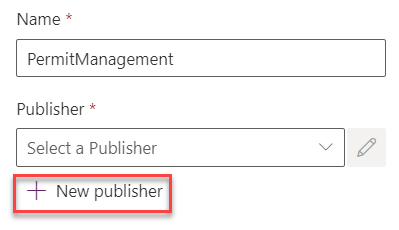
-
Enter Contoso for Display Name and contoso for Name and Prefix.
-
Select Save.
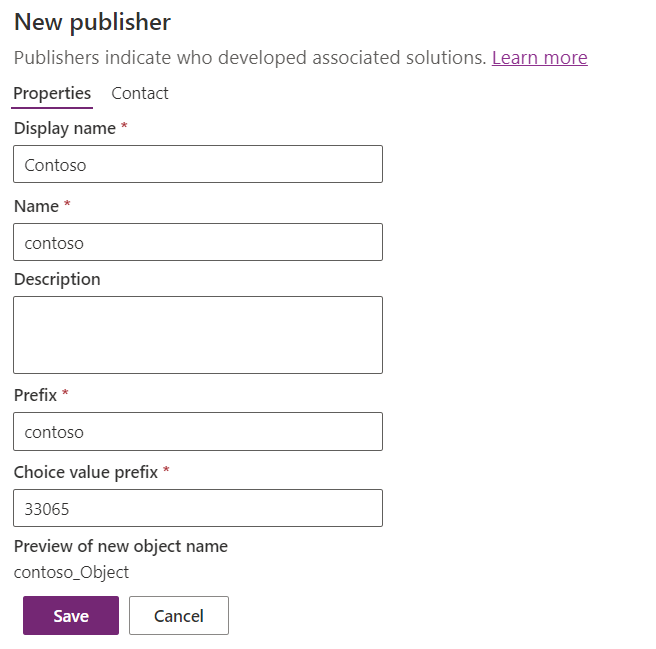
-
Complete the solution creation
-
Now, select on the Publisher dropdown and then select the Contoso publisher you just created.
-
Select Create.
-
Task #3: Add Existing Table
-
Add Contact table to the solution
-
Open the Permit Management solution you just created.
-
Select Add Existing and select Table.
-
Search for contact and select the Contact table.
-
Select Next.
-
Select Select Components.
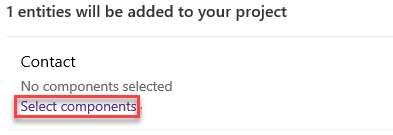
-
Select the Views tab and select the Active Contacts view.
-
Select Add.
-
Select Select Components again.
-
Select the Forms tab and select the Contact form.
-
Select Add.
-
You should have 1 View and 1 Form selected. Select Add again. This will add the Contact Table to the newly created solution.

-
-
Add User table to the solution
-
Select Add Existing and select Table.
-
Search for user and select the User table.
-
Select Next.
-
DO NOT select any components.
-
Select Add.
-
Your solution should now have two tables.
-
Exercise #2: Create Tables and Columns
Objective: In this exercise, you will create tables, add columns to these tables and edit the Status Reason options for the Permit and Inspection tables.
Task #1: Create Permit Table and Columns
-
Continuing in your development environment, open the Permit Management solution
-
Sign in to Power Apps maker portal
-
Select Solutions and select to open the Permit Management solution you created.
-
-
Create Permit table
- Select + New and then select Table.
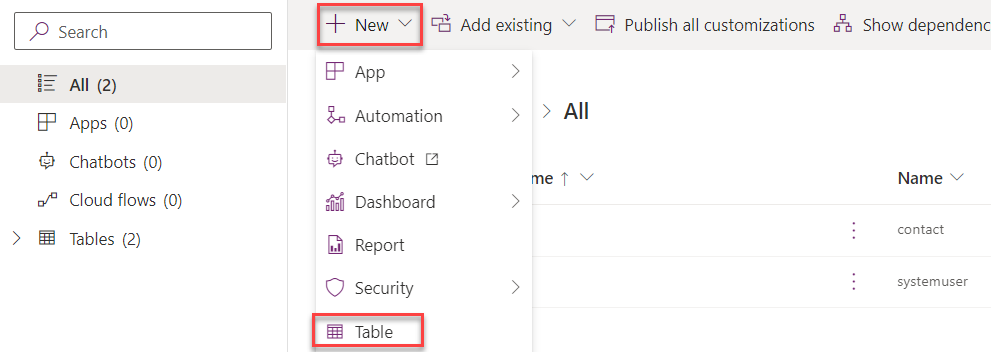
- Enter Permit for Display Name and select Save. This will start provisioning the table in background while you can start adding Columns.
-
Create Start Date column
-
Expand the permit table.
-
Click Columns.
-
Select + New column.

-
Expand Data type.
-
Select Date and Time.
-
Select Date only.
-
In the Required dropdown, select Business required.
-
Select Save.
-
Enter Start Date for Display name.
-
-
Create Expiration Date column.
-
Select + Add Column.
-
Enter Expiration Date for Display name.
-
Select Date Only for Data type.
-
Select Done.
-
-
Create New Size column.
-
Select + Add Column.
-
Enter New Size for Display name.
-
Select Whole Number for Data type.
-
Select Done.
-
Click on chevron icon next to Default
-
Task #2: Create Permit Type Table and Columns
-
Create Permit Type table
- Select All.

-
Select + New and then select Table.
-
Enter Permit Type for Display name.
-
Select Save.
-
Create Require Inspections column
-
Open the Permit Type table.
-
Make sure you have the Columns tab selected and select + Add Column.
-
Enter Require Inspections for Display name.
-
Select Yes/No for Data type.
-
Select Done.
-
-
Create Require Size column
-
Select + Add Column.
-
Enter Require Size for Display name.
-
Select Yes/No for Data type.
-
Select Done.
-
-
Select Save Table.
Task #3: Create Build Site Table and Columns
-
Create Build Site table
-
Select All.
-
Select + New and select Table.
-
Enter Build Site for Display name.
-
Select the Primary column tab.
-
Change the Display Name to Street Address.
-
Expand Advanced options.
Change the Schema name to street1.
- Select Save.
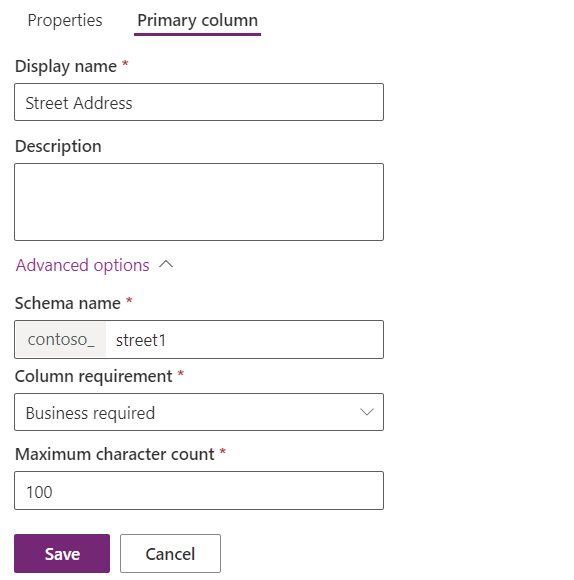
-
-
Add City column
-
Open the Build Site table.
-
Make sure you have the Columns tab selected and select + Add Column.
-
Enter City for Display name and change the Name to city.
-
Make sure Text is selected for Data type.
-
Select Required.
-
Select Done.
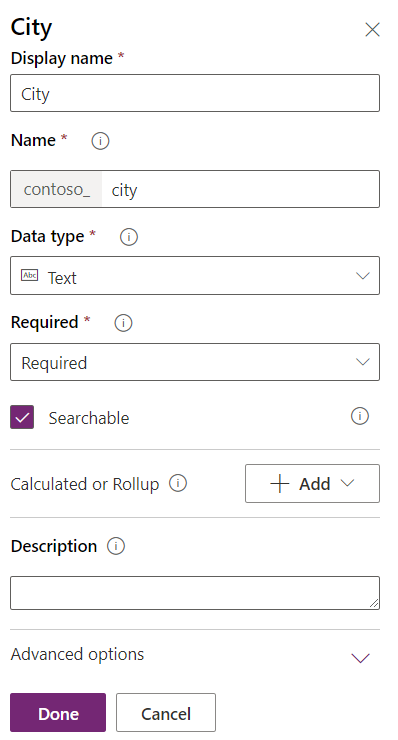
-
-
Add Zip/Postal Code column
-
Make sure you have the Columns tab selected and select + Add Column.
-
Enter ZIP/Postal Code for Display Name and change the Name to postalcode.
-
Make sure Text is selected for Data type.
-
Select Required.
-
Select Done.
-
-
Add State/Province column
-
Make sure you have the Columns tab selected and select + Add Column.
-
Enter State/Province for Display Name and change the Name to stateprovince.
-
Make sure Text is selected for Data type.
-
Select Required.
-
Select Done.
-
-
Add Country Region column
-
Make sure you have the Columns tab selected and select + Add Column.
-
Enter Country/Region for Display Name and change the Name to country.
-
Make sure Text is selected for Data type.
-
Select Done.
-
Task #4: Create Inspection Table and Columns
-
Create Inspection table
-
Select All.
-
Select + New and select Table.
-
Enter Inspection for Display name.
-
Select Save.
-
-
Add Inspection Type Column
-
Open the Inspection table.
-
Make sure you have the Columns tab selected and select + Add Column.
-
Enter Inspection Type for Display name.
-
Select Choice for Data type.
-
Select on the Choice dropdown and select + New choice.
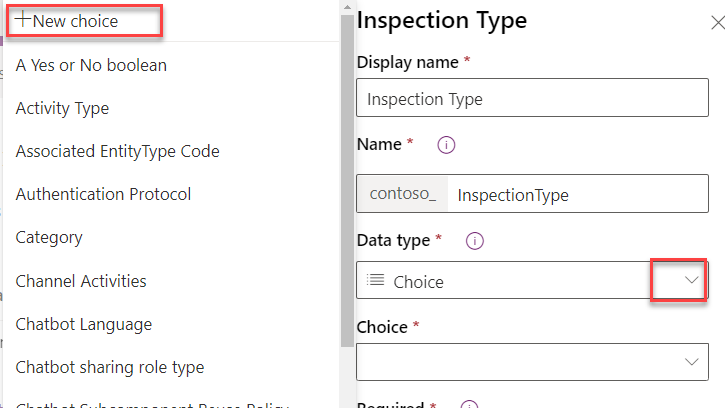
- Enter Initial Inspection and select Add new item.
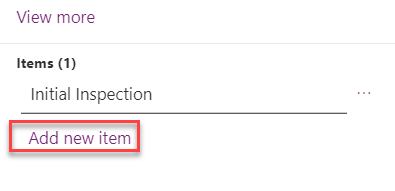
- Enter Final Inspection and select Save.
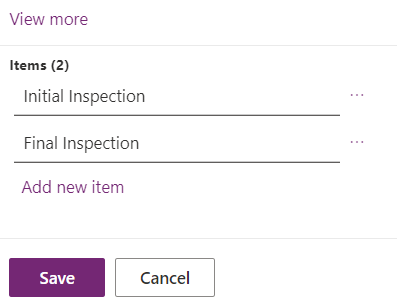
- Click Done.
-
-
Add Scheduled Date Column
-
Make sure you have the Columns tab selected and click + Add Column.
-
Enter Scheduled Date for Display name.
-
Select Date Only for Data type.
-
Select Required.
-
Select Done.
-
-
Add Comments column
-
Make sure you have the Columns tab selected and select + Add Column.
-
Enter Comments for Display name.
-
Make sure Text is selected for Data type.
-
Expand Advanced options.
-
Set Max length to 1000 in the Advanced options.
-
Select Done.
-
-
Add Sequence column
-
Make sure you have the Columns tab selected and select + Add Column.
-
Enter Sequence for Display name.
-
Make sure Text is selected for Data type.
-
Select Done.
-
-
Select the <- Back to solutions button.
-
Select Publish All Customizations.

Task #5: Edit Status Reason Options
-
Open the Permit Management solution
-
Navigate to Power Apps maker portal
-
Select Solutions from the left menu and open the Permit Management solution.
-
-
Switch to Classic
- Select on the … icon and select Switch to Classic.

-
Edit Inspection table Status Reason options
-
Expand Entities.
-
Expand the Inspection table and select Fields.
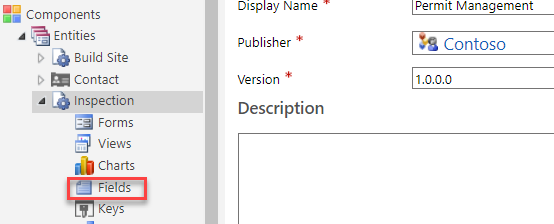
- Locate and double click to open the statuscode Column.

-
-
Change the Active option label
-
Make sure you have Active selected for Status.
-
Select the Active option and select Edit.

- Change the Label to New Request and select OK.
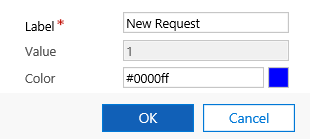
-
-
Add the Pending option
- Select Add.

- Enter Pending for Label and select OK.
-
Add the Passed option
-
Select Add.
-
Enter Passed for Label and select OK.
-
-
Add the Failed option
-
Select Add.
-
Enter Failed for Label and select OK.
-
-
Add the Canceled option
-
Select Add.
-
Enter Canceled for Label and select OK.
-
-
Your option-set should now have 5 options for the Active state.
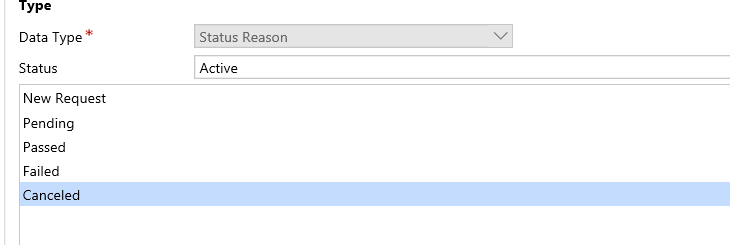
-
Select Pending as the Default Value and select Save and Close from the top menu.

-
Edit Permit table Status Reason options
- Expand the Permit table and select Fields.
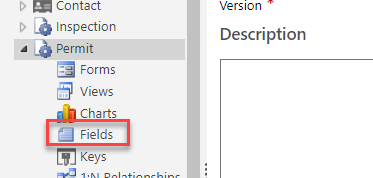
- Locate and double click to open the statuscode Column.
-
Add the Locked option
-
Make sure you have the Active selected for Status.
-
Select Add.
-
Enter Locked for Label and select OK.
-
-
Add the Completed option
-
Select Add.
-
Enter Completed for Label and select OK.
-
-
Add the Canceled option
-
Select Add.
-
Enter Canceled for Label and select OK.
-
-
Add the Expired option
-
Select Add.
-
Enter Expired for Label and select OK.
-
-
Your option-set should now have 5 options for the Active state
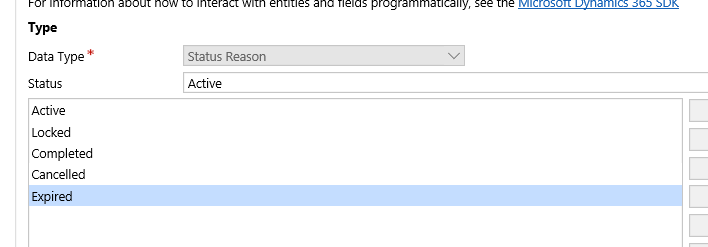
-
Select the Active for the Default Value and select Save and Close from the top menu
-
Select Information from the left side menu and click Save and Close to close classic solution explorer

-
Select the <- Back to solutions.
-
Select Publish All Customizations.
Exercise #3: Create Relationships
Objective: In this exercise, you will create relationships.
Task #1: Create Relationships
-
Open the Permit Management solution
-
Sign in to Power Apps maker portal
-
Select Solutions and open the Permit Management solution.
-
-
Create Permit to Contact relationship
-
Open the Permit table.
-
Select the Relationships tab.
-
Select + Add relationship and select Many-to-one.
-
Select Contact for Related (One) and select Done.
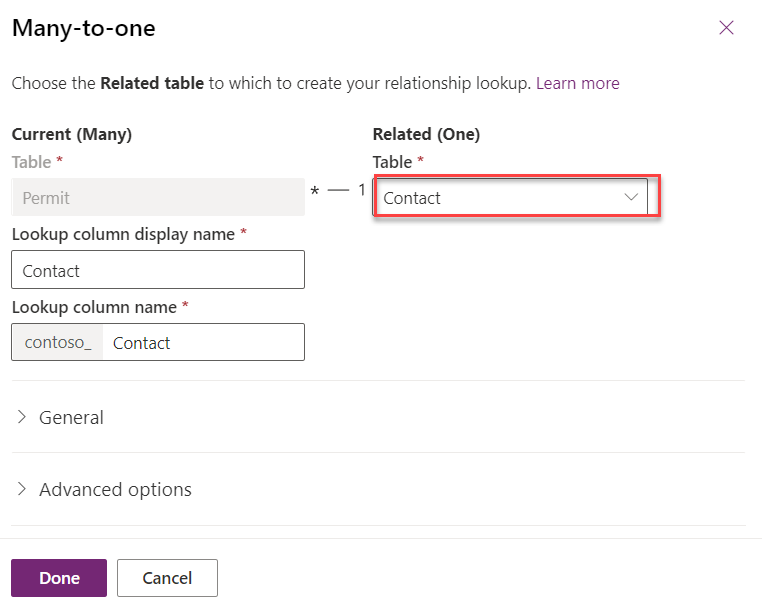
-
-
Create Permit to Inspection relationship
-
Select Add relationship and select One-to-many.
-
Select Inspection for Table in the Related (Many) and click Advanced Options.
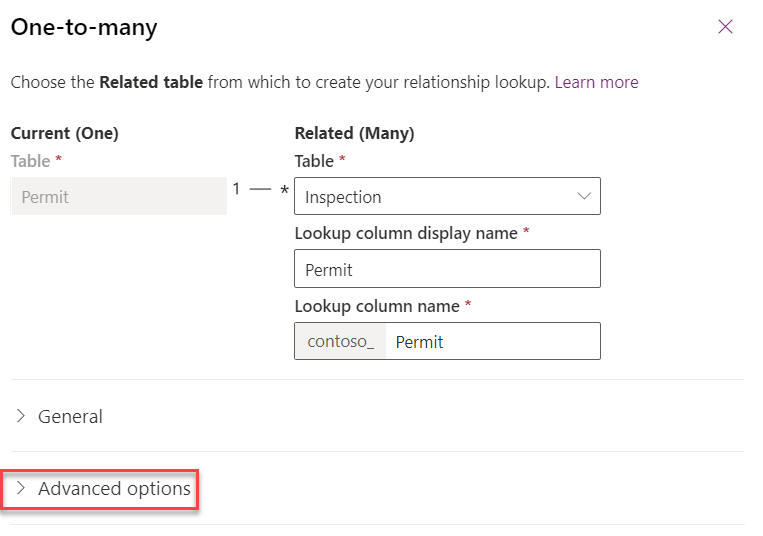
- Change the Type of Behavior to Parental and select Done.
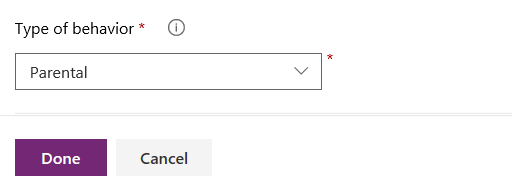
-
-
Create Permit to Build Site relationship
-
Select + Add relationship and select Many-to-one.
-
Select Build Site for Related (One) Table and select Advanced Options.
-
Change the Delete to Restrict and select Done.
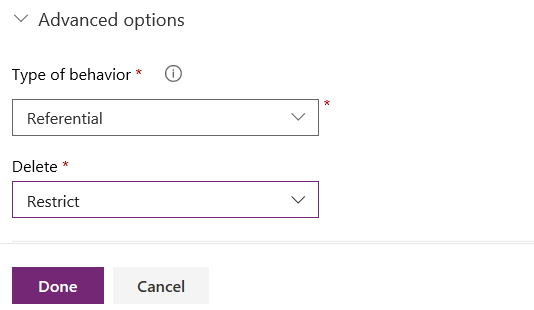
-
-
Create Permit to Permit Type relationship
-
Select + Add relationship and select Many-to-one.
-
Select Permit Type for Related (One) Table and select Done.
-
-
Change the filter to Custom.

-
Click Save Table.
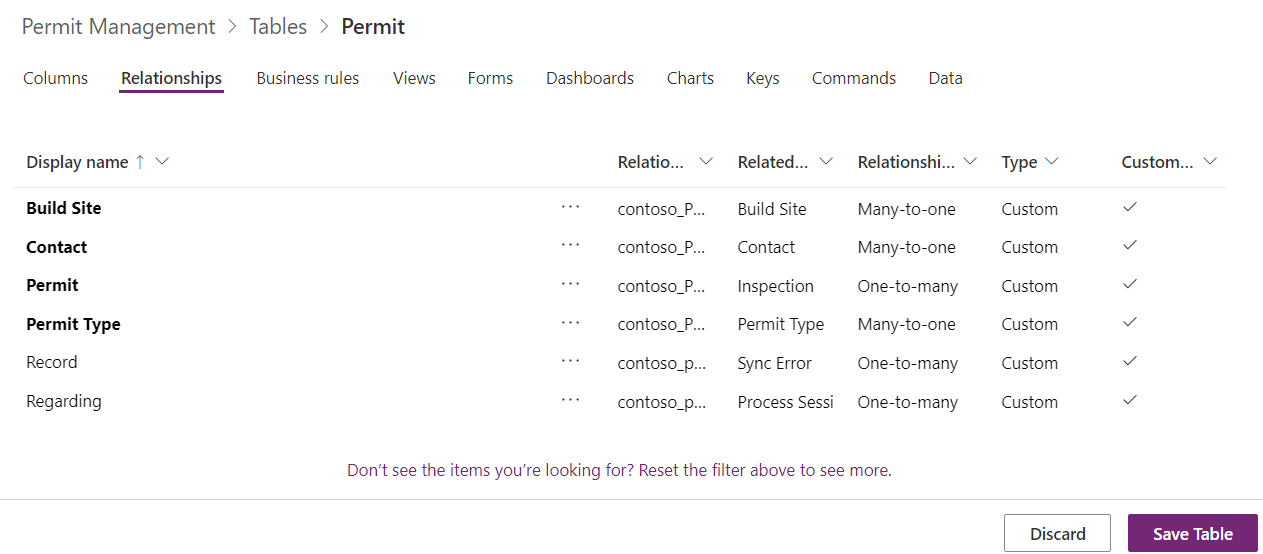
-
Select Solutions from the top menu and click Publish All Customizations.
#